September 15, 2025 • 17 min read
Customer Journey Mapping: Complete Implementation Guide

Content Writer
September 15, 2025

Customer journey mapping is a strategic toolkit that allows businesses to envision every interaction customers have with their brands from first awareness to post-purchase support and advocacy. It’s no surprise, companies are using these: companies who focus on the customer experience (CX) see their revenue rise by 4-8% above their market competitors.[*]
Customer journey maps take in what customers do, how they think and feel about your products and services, and where the friction is happening. In this guide, we’ll walk you through what you need to know about customer journey mapping: the who, what, why, where, when, and hows of implementations. We’ll also discuss different maps and where to drive real results.
What Is Customer Journey Mapping?
Customer journey mapping is the practice of creating visual storylines that capture each touchpoint between a customer and your brand, helping you see through their eyes to grasp what they're feeling, experiencing, and looking for at every stage of their relationship with your business.
These aren't your stereotypical marketing funnels that sometimes get into tunnel vision just on the path to purchase. Instead, journey maps work to illustrate the full width and spectrum of customer interactions. Here are some considerations that it takes: the steps customers take, their emotions and motivations, the big-ticket questions they have for you, and pain points at each stage. This is your holistic telescope into how customers truly experience your brand, rather than just your assumptions about how they see and hear you.
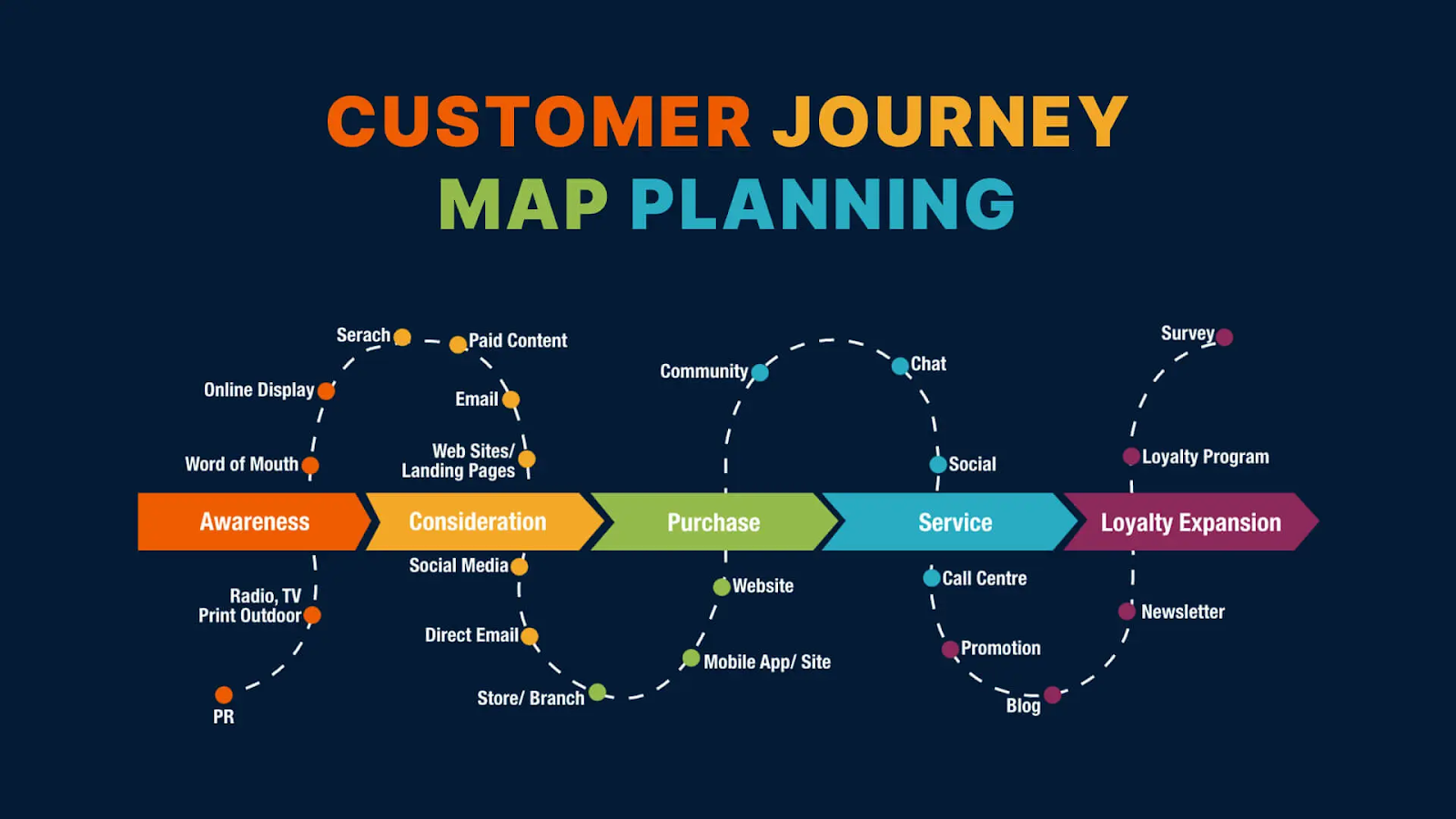
Well-crafted journey maps are a guiding star: they become both a diagnostic tool and a strategic roadmap. Your journey maps show exactly where customers find annoyance or utter delight. Most importantly, these maps transform abstract customer data into a concrete and sharable understanding that drives better business decisions.
Core Components of a Journey Map
A successful customer journey map needs to include a gamut of workable elements to even comprehend or tell the complete customer story. We've aggregated the key elements into a simple bullet list here:
- Customer Personas: Your personas are truly what form the foundation of any journey map. These detailed profiles represent specific customer segments you're mapping, including demographics, goals, behaviors, and preferences. Rather than creating generic profiles, effective personas are based on real customer data and research.
- Touchpoints: Think of these touchpoints as nodes. These are pretty much every interaction point where customers engage with your brand. These include the "in plain sight" channels like your website, social profiles and platforms, customer support, and your IRL stores. But also you need to account for the less obvious touchpoints like billing communications, your packaging resources and stylings, and third-party reviews.
- Customer Actions: Customer actions should be documented to assure stakeholders have the nuanced steps customers take at each journey stage. These might include browsing products, comparing prices, reading reviews, making purchases, or seeking support. Understanding these actions helps teams optimize processes and remove unnecessary friction from key interactions.
- Emotions & Thoughts: You need to capture the internal customer experience throughout their journey. This component reveals how customers feel at each touchpoint and what questions or concerns occupy their minds. Research indicates that emotional connection drives customer lifetime value 52% higher than customer satisfaction alone.[*]
- Pain Points: Pain points mark and identify specific obstacles and grievances your customers will encounter along their journey. Friction areas represent immediate chances to tackle issues to ensure improvement and these issues do correlate directly with increased customer churn and abandonment rates.
- Opportunities: Figure out and highlight the areas that enhance the customer experience and enchant customers from just customers to brand loyalists. Considerations to make include new touchpoints to access even more customers, uncovering your rusty existing processes for future streamlining, or moments where you can exceed customer expectations to create memorable experiences.
Why Customer Journey Mapping Matters
Customer journey mapping shifts the process of how businesses understand to enhance the ways they can serve their customers. Rather than viewing customer interactions as isolated incidents, mapping takes us down to the ground floor to see exactly where they stand. This is a comprehensive understanding of the patterns and connections that your existing and potentially siloed touchpoint analysis and CX measurements misses.
Key Benefits of Journey Mapping
- Uncovers critical friction points: Identifies gaps between departments and channels that create customer-losing risks invisible to teams focused on their specific areas
- Reveals compounding issues: Shows how seemingly minor problems build up to create major customer frustrations. It’s said that 96% of customers experiencing high-effort interactions become disloyal.[*]
- Drives cross-departmental alignment: Unites marketing, sales, product, and support teams under a shared understanding of customer experience
- Centers decisions around customers: Shifts focus from departmental priorities to actual customer needs
- Delivers measurable ROI: Companies with strong customer journey focus see 54% greater return on marketing investment and 79% greater return on sales investment.[*]
Journey mapping transforms isolated data points into actionable insights, helping businesses create seamless experiences that keep customers loyal and drive sustainable growth across all departments.
Types of Customer Journey Maps
Not all journey maps are made equally, they each are meant to serve different strategic purposes. So you do need to be sure you're choosing the most appropriate based on your specific goals and current situation:
Current State Maps
Current state maps document how customers currently interact with your brand across all touchpoints. Current state maps are most suited for the diagnosis of your most pressing existing problems and identifying quick wins for improvement. When you take in and map the actual customer experience rather than your intended one, current state maps work to reveal the surprising gaps between customer expectations and the realities of your operations.
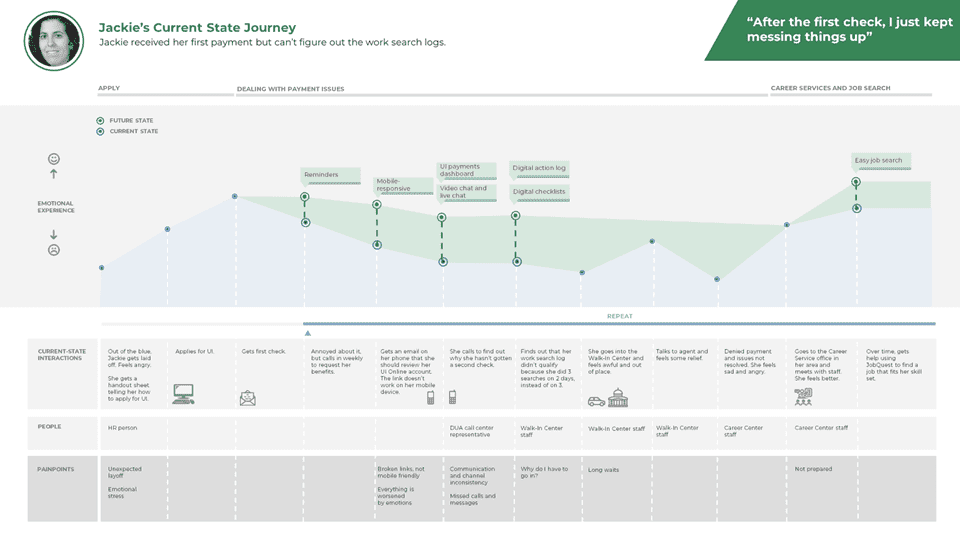
These maps shine brightest when you're troubleshooting specific issues like potential high cart abandonment rates, subpar conversion rates, or frequent support issues piling up. Just one example, but a current state map could reveal customers abandon purchasing from you because shipping costs appear just at checkout, creating an unexpected friction point and sticker shock that drives people away.
Future State Maps
Future state maps visualize the ideal customer journey after planned improvements are implemented. These strategic tools help teams align around a shared vision of the improved customer experience and provide benchmarks for measuring progress toward experience goals.
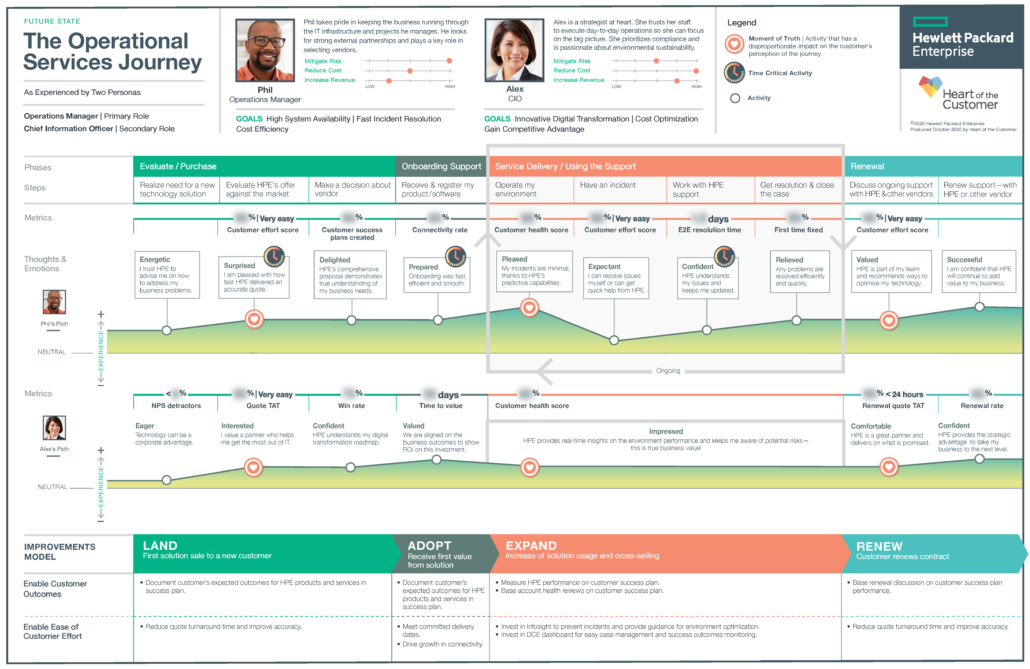
Organizations typically use future state maps during strategic planning cycles or when designing experiences for new products or services. Here's one way a future state map could help, imagine you're launching a new product. When doing that, a future state map helps teams design the optimal introduction and onboarding experience before customers encounter any friction points.
Day-in-the-Life Maps
Day-in-the-life maps are a macroscopic view that goes beyond just your brand to show the customer's broader daily context and what activities they're likely to do with you. These comprehensive maps will point out unmet and shocking needs as well as new chances for you to repair or fortify a relationship by understanding how your product or service fits into the customer's lifestyle or their company's workflows.
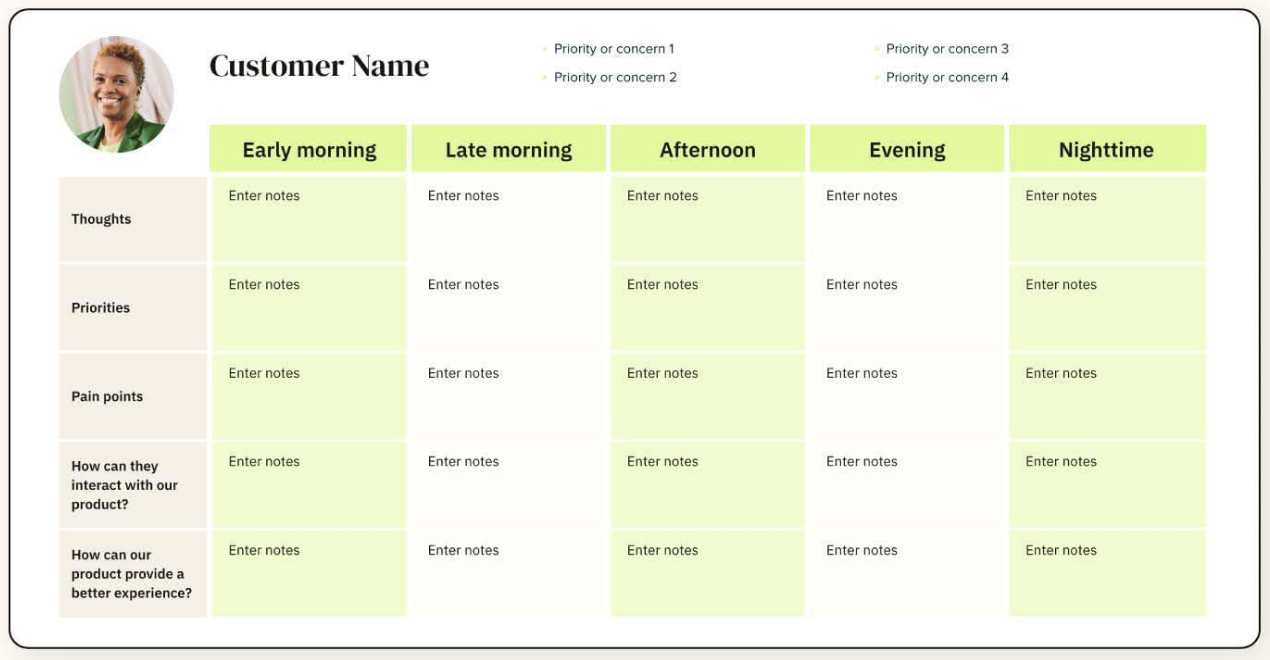
Consider using this form of mapping when you’re identifying new product features, services, or market opportunities. For example, a day-in-the-life map of busy parents might reveal opportunities for a grocery delivery service to integrate with meal planning apps or school pickup schedules.
Service Blueprints
Service blueprints add behind-the-scenes processes and systems to traditional journey maps. They show the internal operations, technology, and employee actions that support each customer touchpoint. This comprehensive view helps organizations identify root causes of service delays or quality issues.
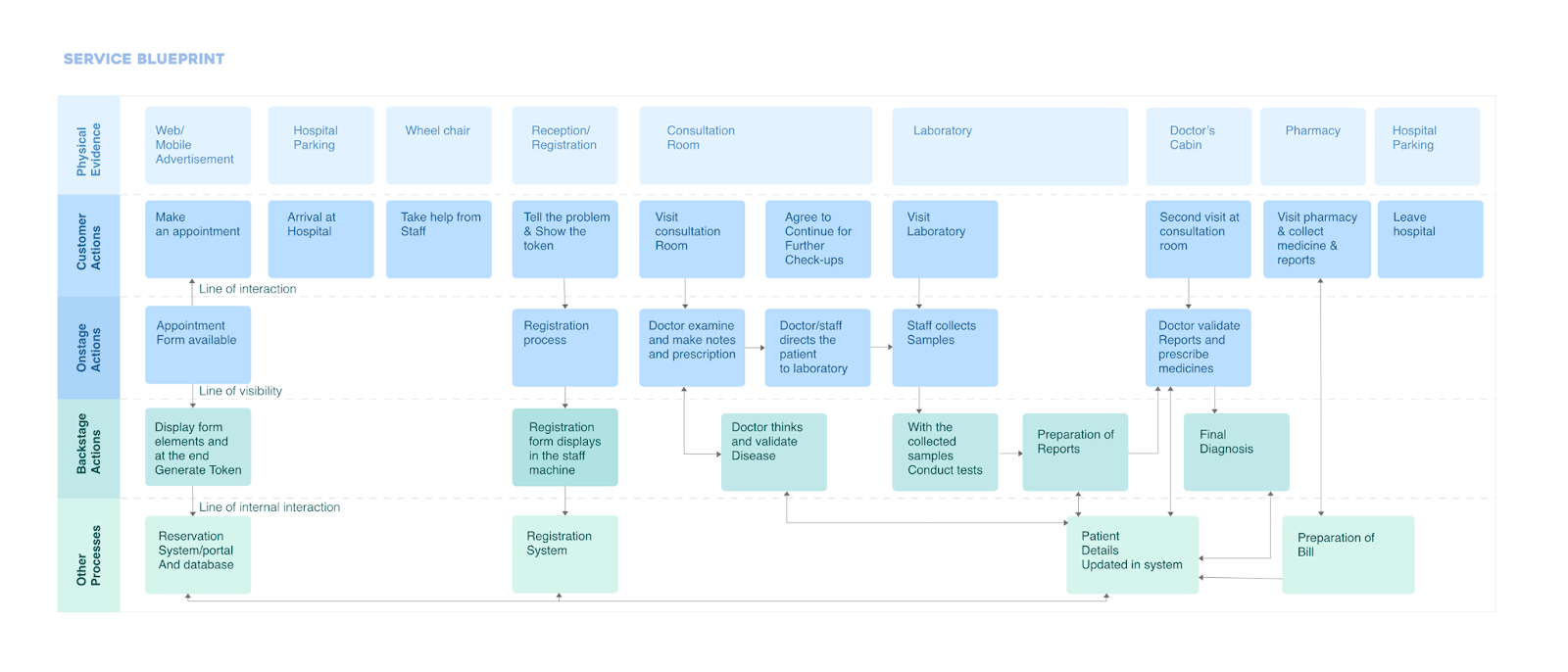
Service blueprints work best for complex service interactions where multiple internal processes affect customer experience. For instance, a service blueprint for customer support might reveal that slow response times result from inadequate staffing during peak hours rather than inefficient agents.
How to Create Your Customer Journey Map
Creating an effective customer journey map means accounting for and doing the hard work of forming a systematic plan then committing to said plan's execution across several key phases. We've outlined a few of these steps for you to make things click into place:
Step 1: Define Objectives and Scope
You need to start by hitting the ground running but also be realistic, to start: consider setting clear but achievable goals for your journey mapping blueprints. Rather than vague objectives like "I just want to improve my CX," define measurable and solid resolutions like "we're going to increase trial-to-paid conversion rate from last quarter's 15% to at least 20% by next year" or "gosh, let's reduce customer support tickets by 25% to make our customers and staff happier."
This means choosing perhaps just one specific customer journey to map rather than attempting to capture everything everywhere all at once. You need to laser in on journeys that directly impact your key business metrics (think new customer acquisition, renewal processes, or support interactions). Ultimately, your mission is to denote and define those success metrics upfront so that your mapping efforts align with business priorities while actually giving out measurable value.
Step 2: Build Your Mapping Team
Be inclusive when creating your super team of associates, consider using representatives from all customer-facing departments to ensure comprehensive perspective and buy-in. Marketing team members provide insights into customer acquisition and awareness-stage interactions. Sales representatives understand conversion processes and common customer objections. Support teams identify frequent pain points and resolution patterns. Product teams contribute usage data and feature adoption insights.
Cross-functional teams improve mapping accuracy by up to 30% compared to single-department efforts, according to research from leading experts.[*] Fostering a collaboration-first environment also ensures your improvement initiatives have support not just from one but all of your departments rather than being a victim to data siloing.
Step 3: Create Customer Personas
Develop one to three detailed personas maximum to maintain focus and avoid over-complication. Each persona you form needs to aggregate and consider relevant demographics, primary goals, their most key pain points, and the best communication channels they use to get to you. Your profiles need to be based on real customer data that you have collected from surveys, interviews, and behavioral analytics rather than those pesky and stereotype-laden internal assumptions about customer preferences.
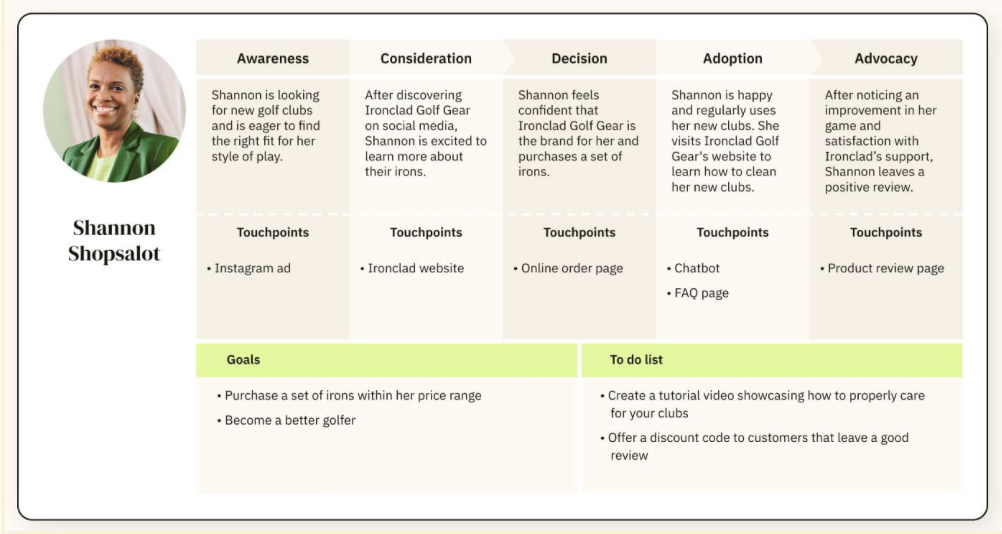
Effective personas give you the scoop on your customers turning them from numbers to characters in a story you're helping to write. For example: "Sally McQueen, a tech-savvy startup founder, seeks scalable solutions that integrate easily with existing tools. She values detailed documentation and responsive support but has limited time for lengthy implementation processes." This level of detail helps team members understand and empathize with actual customer needs.
Step 4: Identify and Map Touchpoints
Comprehensive touchpoint identification requires examining the entire customer lifecycle across all channels and departments.
Pre-Purchase Touchpoints
Pre-Purchase touchpoints tend to capture how customers first discover and evaluate your brand. This includes initial awareness through advertising, referrals, or search results. The research phase encompasses website visits, review reading, demo requests, and competitor comparisons. Consideration touchpoints include pricing page visits, sales conversations, and proposal reviews.
Purchase Touchpoints
Purchase touchpoints focus on the actual decision and transaction moments. The tipping and ultimate decision point may call into question things like existing contract negotiations, final pricing discussions, or even checkout processes. Transaction experiences include payment processing, order confirmation, and immediate post-purchase communications that set expectations for what comes next.
Post-Purchase Touchpoints
Post-purchase touchpoints cover the ongoing relationship after the initial transaction. Onboarding includes account setup, training sessions, and initial product usage. Ongoing touchpoints encompass regular product use, customer support interactions, account management meetings, and renewal discussions. Advocacy touchpoints include review requests, referral programs, and case study participation.
Step 5: Gather Customer Data
Effective journey mapping needs you to consider both solicited feedback and unsolicited behavioral data to properly formulate the accurate and complete visage of your omnichannel customer experience.
Solicited Data Collection
Solicited data collection is just that: it happens when you directly ask customers about your CX via surveys, interviews, and feedback forms. CSAT, Net Promoter, and Customer Effort Scores provide the quantitative measures of experience quality at key touchpoints. However, you need to remember that solicited data captures only what customers say, which doesn't always match their actual behavior.
Unsolicited Data Analysis
Unsolicited data analysis means taking your time to examine what customers actually do through website analytics, heat maps, support ticket analysis, social media monitoring, and session recordings. This data provides 100% response rates and reveals actual behavior patterns that customers might not accurately report in surveys. Combining both data types creates the most accurate and actionable journey maps.
Step 6: Visualize and Validate
When showing off the final products you need to choose a format that suits your audience’s tastes and objectives. Linear timelines work well for straightforward purchase processes, while circular journeys better represent ongoing service relationships. Plot customer actions, emotions, and pain points for each touchpoint, adding an emotion curve that shows satisfaction highs and lows throughout the journey.
Validate your completed map with real customers through interviews or surveys. Focus particularly on the “moments that matter", which in our layman’s terms just means the touchpoints with the highest emotional impact that significantly influence customer satisfaction and loyalty. These validation sessions often reveal assumptions or gaps in your initial mapping.
Analyzing Your Journey Map
Unlock the real value of journey mapping when you take the proper steps and considerations when extracting actionable insights from your completed visualizations and maps. Below we have three considerations that more or less demarcate where and when your analysis is doing its job:
Identifying Moments That Matter
Focus on finding points of highest emotional impact where customers form lasting impressions of your brand. The most pertinent and lasting moments often determine the outcome of your customers choosing to continue their journey with you or abandoning you for another rival. Scour what touchpoints exist where emotions spike positively or negatively, as these underscore an outsized influence on overall satisfaction and loyalty.
Prioritize improvements based on both emotional impact and business influence. For example, think about car purchases. Studies show that the vehicle delivery moment carries the highest emotional weight and value for customers, making it a critical experience to not screw up even though it's brief compared to the research and financing phases.[*]
Uncovering Pain Points and Opportunities
Systematic analysis reveals patterns that drive customer frustration and identify improvement opportunities. Look for emotion drops and friction areas where customer satisfaction decreases significantly. Identify disconnects between different channels where customers receive conflicting information or inconsistent service levels.
Map for the gaps between customer expectations and your current actual experience delivery. Be sure to categorize and highlight potential improvements as quick wins as these will require the most minimal resources versus the more strategic improvements. Those will need a significant commitment towards investment but will offer greater and lasting impact. Prioritization helps teams focus on changes that provide the greatest return on investment while ascertaining a level of trust from higher-tier stakeholders who sign off on budgets.
Measuring Journey Success
Establish the most pertinent key performance indicators for each critical touchpoint to track improvement over time. Monitor journey completion rates to understand where customers drop off and how changes affect progression through key processes. Track satisfaction scores at moments that matter to measure experience quality improvements.
Calculate the business impact of journey improvements through metrics like customer lifetime value changes, conversion rate improvements, and support cost reductions. Example metrics include time-to-value for new customers, customer effort scores for support interactions, and completion rates for onboarding processes.
Customer Journey Mapping Examples
Here are a few ways different industries use and apply journey mapping to solve specific business challenges. We’ve covered three major industries: SaaS, E-Commerce, and Services.
SaaS Journey Maps
Software-as-a-Service companies tend to use journey mapping when they do trial-to-paid conversions in which free users need to perceive a level of “satisfaction” or value to justify eventually subscribing or purchasing a product for widespread use. Key touchpoints can encompass the initial sign-up process, how onboarding goes, the first value achievements, and the points where businesses consider making upgrade decisions.
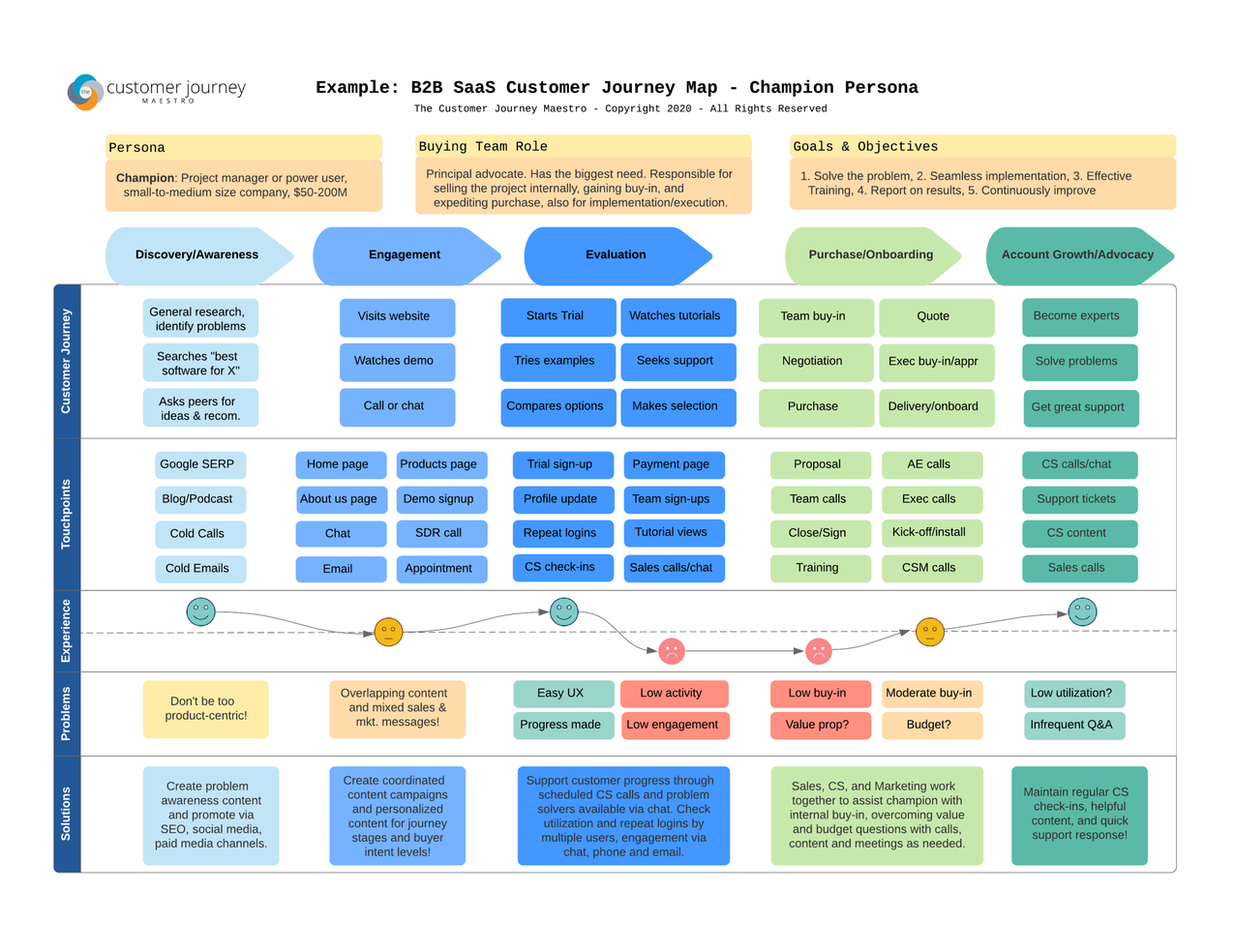
However, common pain points can lead to customer dissent and mapping takes the guesswork out of that. Overly complex onboarding can cut the time-to-value pipeline or perhaps the upgrade paths are so unclear customers get decision paralysis when choosing a tier with features they might know they need or want. The best improvements are on guided setup processes to help your users actually get their first meaningful outcome ASAP which in turn cuts the time between sign-up and value realization.
E-commerce Journey Maps
E-commerce journey maps tend to encompass the nuances of the e-commerce CX journey in which factors like browse-to-purchase experiences, how customers find your products and eventually do complete the transaction and make the sale. Critical points of interest tend to hover around how detailed product pages are, the ways customers can interact with their cart and do checkout, as well as the functionality of your searchability.
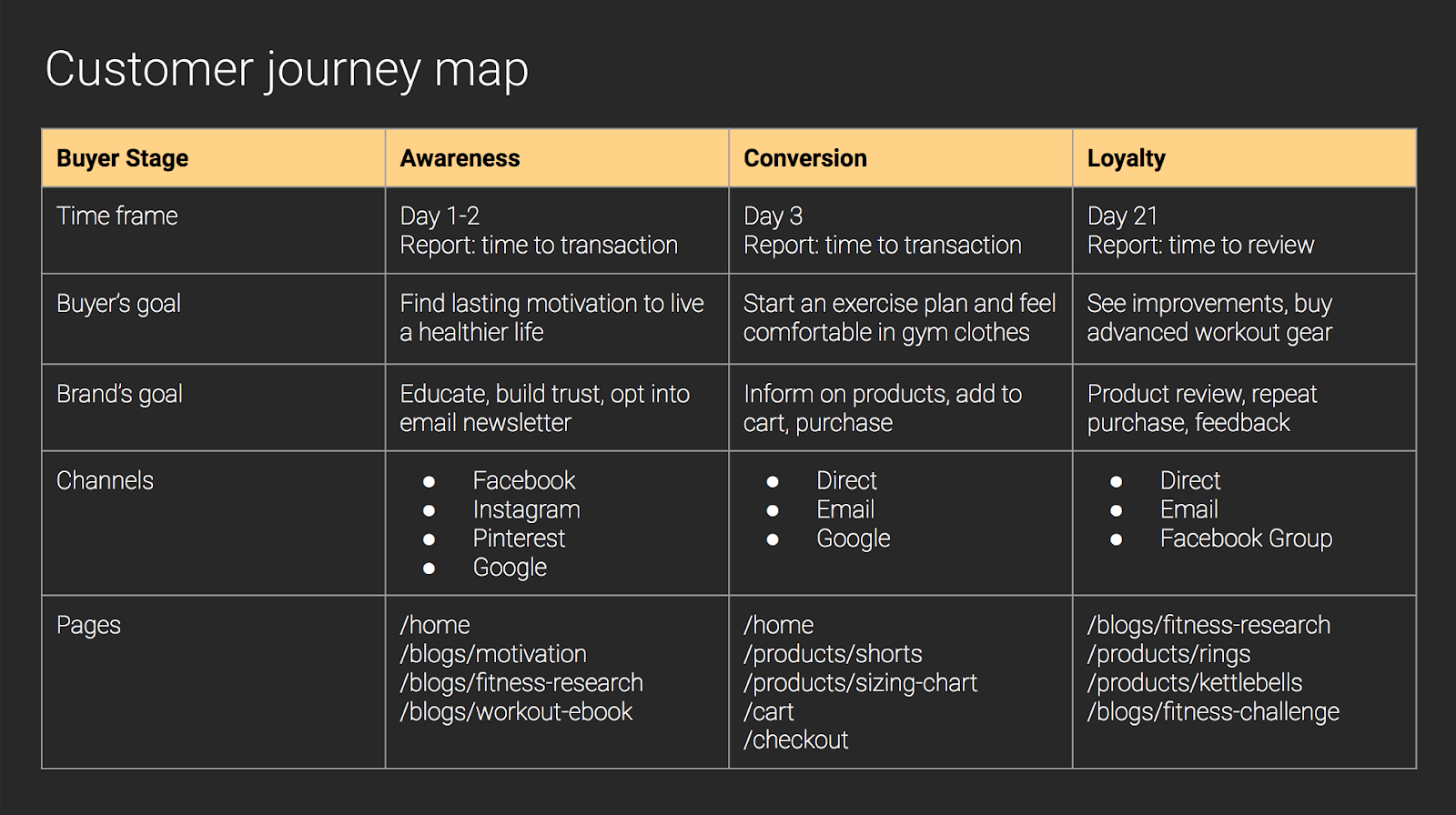
A big pain point some customers say is unexpected shipping costs which lead to eventual cart abandonment at the last minute. 48% of customers say they’ll drop a potential purchase if they see any unexpected costs towards checkout.[*] Some retailers will cut to the heart of the issue by showing off transparent price information way early into the shopping journey to keep those unsavory surprises at bay and keep customers in the loop.
Service Industry Journey Maps
Service industries tend to use mapping for nuances like inquiry-to-service and whether that journey is completed, while also finding where potential customers form into paying and steady clients who receive consistent service delivery. The key points of interest and touchpoints you need to account for here are initial contact methodology, the ways you quote or propose processes, the scheduling of service implementation and eventually the delivery itself.
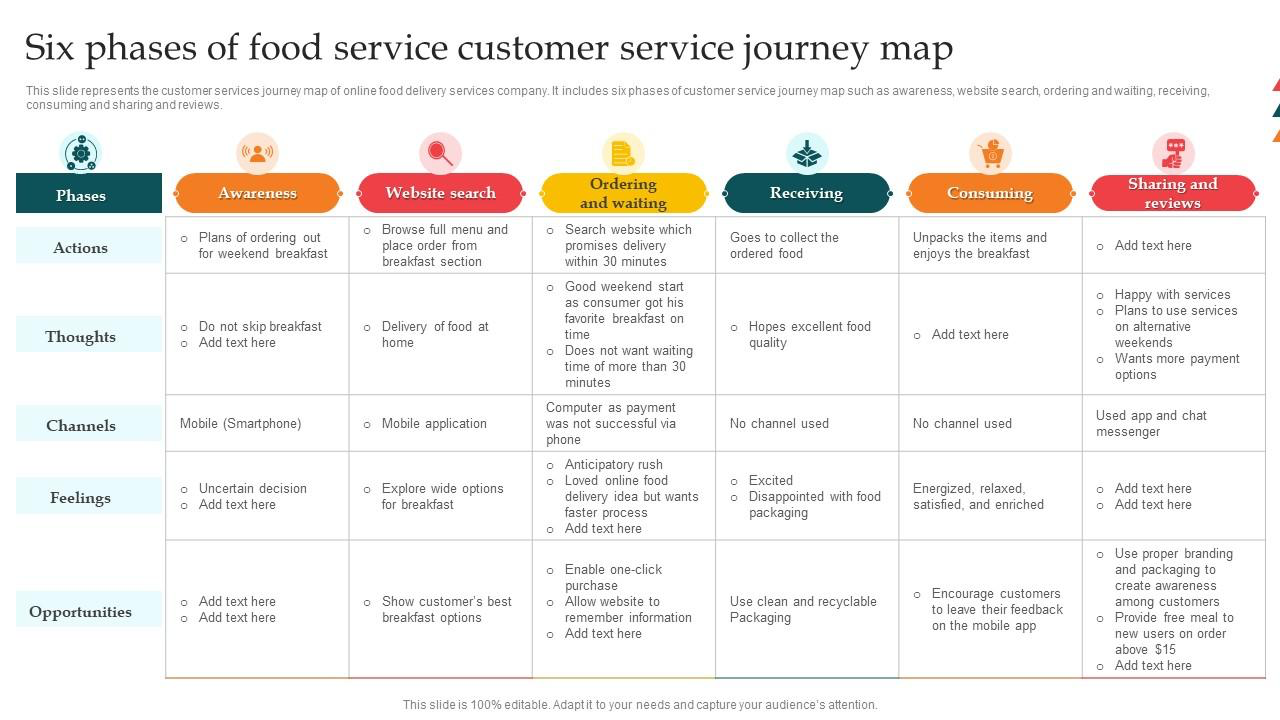
It’s the tough issues like unclear communication about progression of services and delivery that create the friction and frustration in service industries like food delivery where customers just are left hanging on timing and next steps. Be sure to create proactive status updates and milestone communications to resolve the issues and build out better satisfaction scores.
Common Journey Mapping Mistakes
Several commonplace snafus can undermine journey mapping effectiveness and reduce the value of your efforts. Avoiding these critical mistakes improves your mapping success:
- Mapping in silos without including all relevant departments from the start leads to incomplete perspectives and limited buy-in for improvements
- Ignoring emotions despite research showing that feelings drive 69% of customer experience perceptions and decisions
- Taking a one-and-done approach when journey maps need regular updates to remain accurate as customer behavior and business processes evolve
- Creating too many personas instead of starting with 1-3 maximum to maintain focus and avoid over-complication
- Taking too much stock in assumption-based mapping rather than using data and other validating insights bolstered with real customer data and feedback
- Being narrow-minded and taking on just your digital CX strategy touchpoints while ignoring offline channels and interactions that still influence customer experience
Each of these mistakes reduces mapping accuracy and limits the practical value of your customer journey insights.
Making Journey Mapping Work
Customer journey mapping transforms abstract customer information and complaints into concrete ways you can drive measurable business results. Success means getting true cross-functional assurances beyond doing a few mapping workshops. Teams must dedicate resources to actually do your identified improvements and measure these impacts over time.
When you're ready to get started, be sure to choose one critical customer journey directly hitting your key business metrics. Then, begin mapping it this week and focus on gathering real customer data and involving representatives from all relevant departments. This way you can ensure you not only have a comprehensive understanding but the might of organizational support when implementing your improvements.
FAQs
A basic journey map typically takes 2-4 weeks from initial planning to completion, depending on the complexity of the journey and availability of customer data. More detailed maps with extensive validation may require 6-8 weeks.
Start with one map for your most critical customer journey, then gradually add 2-3 additional maps for other key processes. Most businesses benefit from 3-5 focused journey maps rather than attempting to map every possible interaction.
Journey mapping focuses on specific customer interactions with your brand, while experience mapping examines broader customer experiences that may include multiple brands and touchpoints outside your direct control.
Review and update journey maps quarterly or whenever you make significant changes to customer processes, launch new products, or notice shifts in customer behavior patterns.
Absolutely. Small businesses often have fewer resources to waste on ineffective touchpoints, making journey mapping even more valuable for identifying high-impact improvements and focusing limited resources effectively.
Begin with basic customer analytics, support ticket data, and feedback surveys. You can create initial maps with limited data and improve accuracy through customer interviews and additional research as you progress.